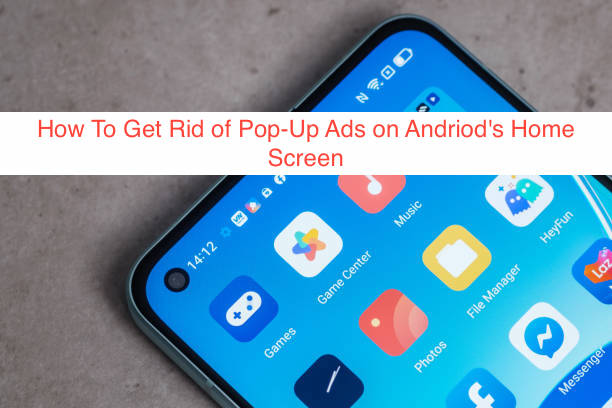Do you use an android device if so, then you’ve probably encountered at least one of those annoying pop-up ads on Andriod’s home screen. Pop-ups can be used to promote apps or sites or they can simply be there to create noise and draw your attention away from the task at hand but no matter what their purpose they’re almost always frustrating to deal with below we have written 5 ways to get rid of them?
Five Ways to Get Rid of Pop-Up Ads on Andriod’s Home Screen
- Turn off show notifications for
If you’re tired of being constantly barraged by notifications, it’s easy to get rid of them. Just head into your phone’s settings, click Apps and then choose either show notifications or don’t show notifications. If you don’t want ads to show up in your notification area at all, though, you’ll need to go into your device’s default launcher—the app that controls things like wallpaper and which apps appear where—and turn off notification access for any apps you have installed.
For example, if you have Facebook installed (I’m guessing yes), go into its settings and uncheck show notification content. You should also check out Google Play Services, which handles a lot of Google’s messaging services.
We can find it under Apps > All. Click on each one individually and disable Show Notifications Access. And while you’re in there, scroll down until you see an option called Notification Listener Service. Uncheck that as well. It will no longer receive data from other apps about what is happening within them, so they can’t send alerts to your lock screen or notification shade anymore. This won’t remove those alerts from your device entirely; instead, they’ll just stop showing up outside of those individual apps’ windows when opened again later.
- Go incognito
If you’re a frequent user of apps, you might have noticed that some do not allow you to close their ads by tapping outside of them. This can be annoying when those ads take up more than half your screen real estate and make it impossible for you to close out the app in question.
If that sounds like a familiar situation, try going incognito. On an iPhone or iPad, go into your settings and toggle private browsing on. Then, open up any app with a persistent ad. The ad should disappear after about 30 seconds—just long enough for you to get rid of it without having to restart your device.
For Android users, simply swipe down from any corner of your screen and tap Private Browsing at the top. Then, open up any app with a persistent ad.
The ad should disappear after about 30 seconds—just long enough for you to get rid of it without having to restart your device! The digital age has brought about many changes in how we consume media. You may read books on your tablet or watch movies on your smartphone; these are all relatively new forms of entertainment that wouldn’t have been possible ten years ago. But what’s exciting is all the different ways we now interact with our favorite media; music streaming services, podcasts, and online video platforms such as YouTube are just a few examples.
For choosing which service(s) you’ll use, price is often one of the most important factors. Most services offer a free trial period where you can try before you buy (or try before you commit, as they say). Here are some other factors to consider
- Add pop-up blocking software
If you’re using an Android device, there are a lot of things you can do to prevent pop-ups from interrupting your browsing session. The first step is to download an ad blocker app like Adblock Plus or Blocker.
Once you have those installed, they should work in tandem with your browser, preventing ads from appearing and stopping new ones from loading. It doesn’t eliminate all ads—it just stops them from showing up in places where they get in your way. Be aware that adblockers will hurt sites like Gawker Media (which runs almost entirely on advertising) by blocking their revenue stream. But if you don’t mind doing that, it could be worth it for you.
- Try an ad blocker app
For years, desktop and laptop users have been able to use software known as adblockers to hide unwanted advertisements. Now, with online advertising dominating a huge percentage of traffic, mobile users can make use of those same tools.
To install an ad blocker app on your Android device, search for ad blocker on Google Play. Once you’ve found one that seems like it will fit your needs (and please be sure to read user reviews!), just tap Install and wait for it to download. The installation process varies depending on which adblocker you choose.
You may need to restart your phone or tablet after installing an ad blocker for it to work properly. If you’re using a different platform other than Android, try searching for an ad blocker in your app store of choice. There are plenty of options available! Here’s a quick rundown of what some popular ad blocker apps do:
- Adblock Plus – An all-inclusive solution for blocking ads from appearing anywhere on your device.
- Disconnect – This allows you to block data trackers that could slow down page load times and drain battery life.
- 1Blocker – This handy tool allows you to quickly toggle ads off or on for specific websites within Safari Mobile, so if there’s one site that has annoying ads you don’t want to see, 1Blocker makes it easy to disable them. Some Kind of Awesome – A smart way to enable content blockers; works well with Safari Mobile but doesn’t offer much control over individual sites.
- Crystal – A lightweight alternative app made by iOS developer Christian Selig.
Conclusion
This article has shown you how to get rid of pop-up ads on Andriod’s home screen. If the ads persist, we advise you to factory reset your phone.

